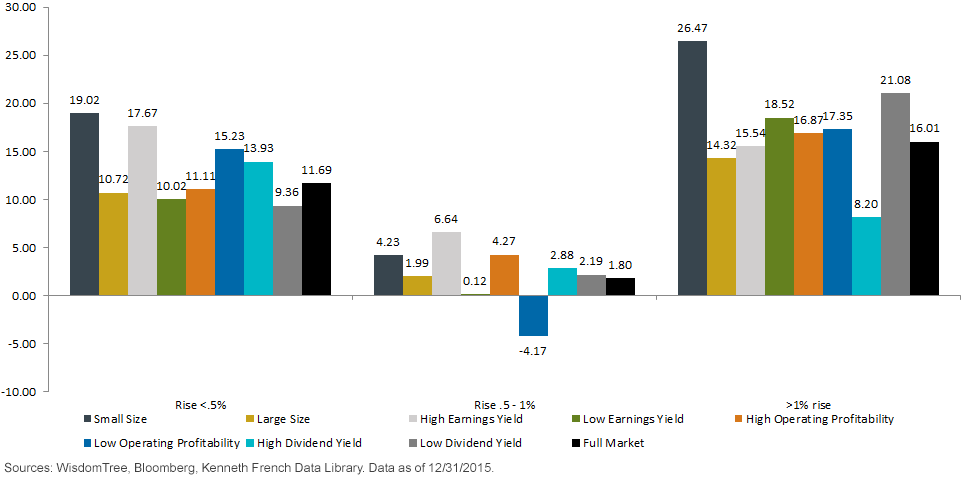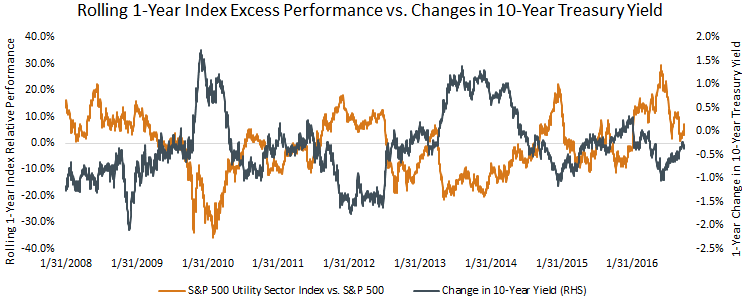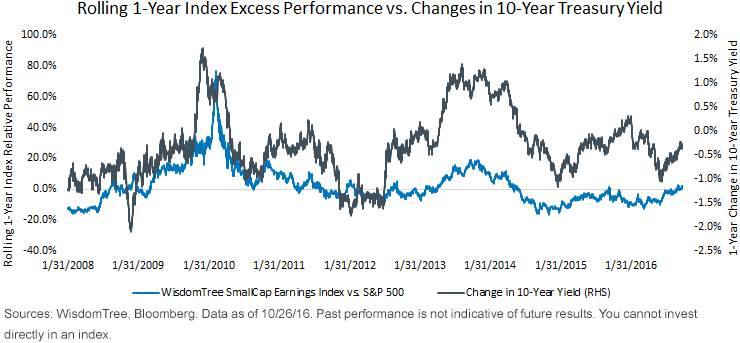What Factors Outperform When Rates Rise?


President-elect Trump scored a surprising victory on November 8, and one of the big market reactions the day after the election was a large pickup in interest rates. We addressed this theme recently, in a post about how low-volatility strategies and sectors such as Utilities could be vulnerable to rising interest rates. Below, we discuss how various investment factors have performed in different rising rate scenarios.
Previously, we discussed how Japan was one of better hedges against rising interest rates. But focusing on the U.S. equities here, we also found that while rising rates were generally positive for equities, small caps performed particularly well during these times. Outside of small caps, taking a deeper look within the equity market reveals more information about which other individual factors outperformed during these times of rising rates.
Average Annual Performance During Increases in 10-Year Treasury Yield Since 12/31/1963

We divided the universe of U.S. stocks into quintiles by several factors—market capitalization, earnings yield, operating profitability and dividend yield—and analyzed the top quintile against the bottom quintile for each.
Even though fixed income yields generally have been falling since the mid-1980s, 27 of the last 52 calendar years have seen an increase in the 10-Year U.S. Treasury yield. Of those 27 years, yields have risen to various degrees. In years that saw yields increase by less than .50%, we generally see that the factors we know to outperform over time—small caps, high earnings yielders and high-dividend payers—did exactly that. Interestingly, companies with low operating profitability outperformed those with high profitability, but by the smallest margin of all the factors we measured.
Big Moves in Rates Had Strong Equity Markets
In years that saw interest rates rise more than 1.00%, every factor except one returned at least 14.32%, once again led by small caps (these years were the typical “risk-on” years, such as 2009 and 2013). The only factor to significantly lag the market was the highest-yielding stocks, which we would expect to underperform in a rapidly rising yield environment.
However, for investors that believe we will see interest rates increase at a moderate pace, looking specifically at times when yields rose between .50% and 1.00% may be the most informative, as these periods show us a significant divergence between factors.
Repeating a common theme, small-cap stocks outperformed large caps. However, earnings yield and operating profitability appear to be even stronger indicators of outperformance during these occasions. The top stocks by earnings yield outperformed the bottom stocks by an average of more than 6.5% per year. Further, companies with high operating profitability outperformed those with low profitability by nearly 8.5% per year. High-yielding stocks narrowly beat low-yielding stocks over the last 40-plus years, implying that the income cushion provided by dividend payers can help offset the loss in principal during moderate rises in yields.
What does this tell us about how to position portfolios? We recommend positioning toward strategies that are small-cap focused with high earnings yields and strong operating profitability, as those should do well in a rising rate environment.
The WisdomTree Earnings Index Family: Tilts toward Profitability and High Earnings Yields
WisdomTree has a small-cap strategy that assigns greater weights to the most profitable companies and each year rebalances toward stocks with high earnings yields—the WisdomTree SmallCap Earnings Index.
To confirm our beliefs, we analyzed the excess return of the WisdomTree SmallCap Earnings Index against the S&P 500 Index on a rolling one-year basis since the WisdomTree Index’s inception in 2007. We also looked at the rolling one-year excess returns of the S&P 500 Utilities Index over the broader S&P 500 Index, as we’ve just seen a period with significant outperformance of this sector, followed by the past few months, where we witnessed a distinct change in trend as the 10-Year Treasury yield began to rise.
Since we already know the Utilities sector has a record of doing well (especially recently) in falling interest rate environments, does the WisdomTree SmallCap Earnings Index provide complementarity by generating excess returns during past rising interest rate environments?


The excess return of the WisdomTree Index tends to move along with changes in the 10-Year yield; in fact, the two variables have a correlation of .54. This means that there is a relatively strong positive relationship between rising yields and times when the WisdomTree SmallCap Earnings Index outperforms the S&P 500. On the other hand, the correlation between the S&P 500 Utility Index’s excess performance and changes in yields was -.76, which marks a very strong inverse relationship and, should interest rates start to rise, represents an area of caution for strategies that have large weights in the sector.
We believe the WisdomTree SmallCap Earnings Index effectively captures the factors that historically have performed best in times of rising interest rates, and the Index has a track record of outperformance during these times, which helps validate our suspicions. Should investors expect interest rates and yields to rise in the coming months, they may be hard-pressed to find a strategy better positioned for potential outperformance.
Unless otherwise noted, data source is Bloomberg, as of 10/26/16.


